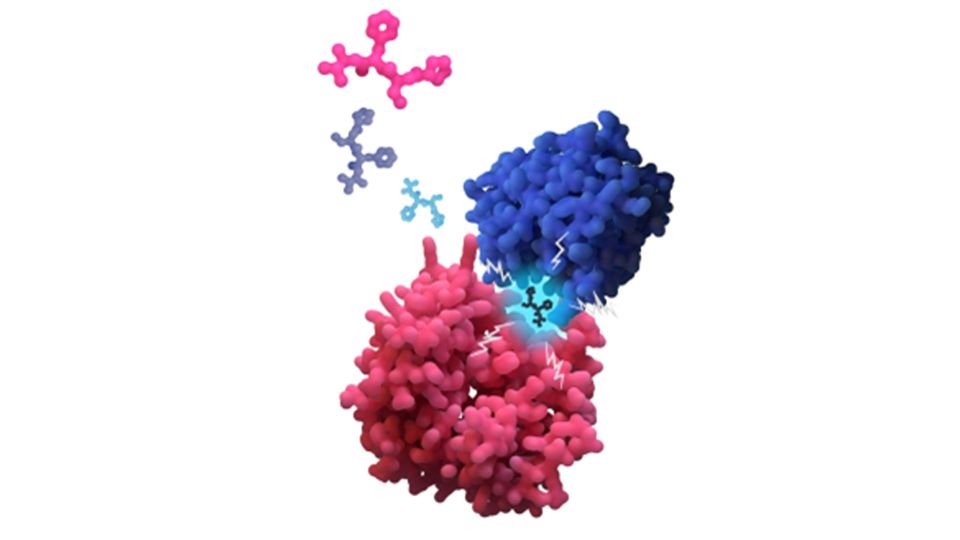High-Throughput Effector Protein Remodeling for Molecular Glue Drug Discovery
Agnostic platform could overcome challenges in molecular glue identification

Molecular glues hold strong therapeutic promise for approaches such as targeted protein degradation (TPD) and beyond, yet systematic identification remains challenging. Methods such as brute-force screening or guided design via machine learning can be low throughput and non-physiological.
In our study, undertaken at PhoreMost, UK and published on bioRxiv, we developed GlueSEEKER® to overcome this, using pooled intracellular screening with engineered effector proteins to trigger non-native substrate degradation. Harnessing the biochemical and pharmacochemical traits of mutated surface residues, we can guide and accelerate glue molecule discovery.
Reprograming effector protein surfaces to fast-track molecular glue discovery
TPD relies on two main modalities: bivalent proteolysis targeting chimeras (PROTACs), consisting of linked ligase- and target-binders, and monovalent glues, small molecules that alter effector protein affinity for non-native substrates. The majority of TPD therapeutics are dominated by a few E3 ligases, mainly von Hippel-Lindau (VHL) and Cereblon. Expanding this repertoire will broaden tissue and application reach while mitigating resistance.
Molecular glues offer major therapeutic advantages over bivalent degraders due to their smaller size, which improves solubility and oral bioavailability. This same feature is their Achilles’ heel. Unlike PROTACs, which depend on ligandable pockets and are more straightforward to design, glues have unpredictable structure–activity relationships (SARs) and mechanisms of action (MoA), often requiring crystal structures for prediction.
There is therefore an unmet need for a systematic, rational approach to molecular glue discovery – especially for targeting undruggable, disordered proteins incompatible with bivalent PROTAC design. Such technology could both expand E3 ligase diversity and extend beyond TPD applications.
GlueSEEKER-enabled neosubstrate degradation of GSPT1 via the E3 ligase Cereblon
In this study, we describe the first end-to-end GlueSEEKER® application for TPD, systematically remodeling the E3 ligase Cereblon to degrade G1 to S phase transition 1 (GSPT1). The platform operates by inserting an amino acid surface-loop library into Cereblon to generate new bioactive properties. These are lentivirally introduced so that each cell expresses one novel effector protein variant and these are then screened for a defined biological phenotype. Bioactive mutations that induce GSPT1 degradation are identified using massively parallel sequencing.
To explore small molecule translation, we used chemical and geometric properties of neomorphic Cereblon for in silico structural modeling and virtual screening, ultimately identifying novel compounds that degraded GSPT1.
The key findings of the paper were:
- High-throughput mutational scanning allowed re-engineering of the E3 ligase Cereblon to degrade the oncology target GSPT1
- Global proteomic analysis of active mutants supports a selective degradation mechanism, an important parameter in minimizing off-target effects
- The properties of active insertions enabled and expedited the computational discovery of small molecule glues that induced the degradation of GSPT1 via Cereblon
- The platform can be deployed to a multitude of E3 ligases and target proteins, including applications to effector proteins beyond the realms of TPD
Tackling the serendipity bottleneck via systematic and scalable glue discovery
The screen identified surface mutations in Cereblon that caused GSPT1 degradation in both the absence and presence of the immunomodulatory drug (iMiD) pomalidomide. The properties of the pomalidomide-induced bioactive insertions informed virtual screen-derived compounds. Encouragingly, 40% of compounds formed ternary complexes between Cereblon and GSPT1 in vitro and degraded GSPT1 in cells, highlighting the utility of the platform for expedited glue discovery. In addition, a weaker subset of inserts induced GSPT1 degradation in the absence of the iMiD, opening the avenue for completely de novo degradation and compound development.
As GSPT1 is an essential gene, a cell fitness arm was explored in parallel to add further confidence to the hit phenotype. In this arm, there were also Cereblon mutations that caused cell lethality without impacting GSPT1 levels, showcasing that the platform could re-engineer the same E3 ligase to degrade multiple targets within the same pooled screen format. This remains to be investigated further.
Our findings expand on prior work by Chen et al. that explored medullablastoma-associated gain-of-function mutations in the E3 ligase KBTBD4 causing neosubstrate degradation. This phenotype could be mimicked by the molecular glue UM171, via the same electrostatic interactions with the novel targets. Here, we show a prospective approach based on the principle that amino acid features can inform small molecule properties, which we deployed systematically.
The most immediate impact of this programable platform is the expedited discovery of targeted molecular glues with predictable MoAs. E3 ligase selection is unlimited in this approach, thus tackling the overreliance on glues using Cereblon and VHL, which do not have desired tissue- and disease-specific applications. Additionally, this can create therapeutic avenues for previously undruggable proteins and ameliorate resistance mechanism vulnerabilities. With each GlueSEEKER screen, the platform incorporates insights from previous results, identifying productive library insertions and suitable integration sites. These findings inform subsequent cycles, supporting ongoing refinement of the technology’s performance and applications.
While the GlueSEEKER platform is designed to overcome the reliance of glues on a narrow subset of E3 ligases, this initial application uses Cereblon, one of the most overused modalities. We are actively expanding beyond this, having successfully applied the platform to another E3 ligase. Furthermore, while we have validated Cereblon insertions that degrade GSPT1 without pomalidomide, the effect is more modest than under pomalidomide-active conditions, currently limiting the impact of de novo compounds. Broader TPD applications will strengthen confidence in the platform’s utility.
Idealistically, the platform would enable reprograming of any E3 ligase to any target. Realistically, structural constraints impose limits, such as at the loop insertion site or in library design. Still, with over 600 E3 ligases available, we consider this a manageable and acceptable limitation. Additionally, GlueSEEKER currently uses pooled screening and lentivirus, unsuitable for some disease models, especially those dependent on intercellular signaling or resistant to transduction, requiring case-by-case solutions.
Another key limitation in the molecular glue field is restricted therapeutic application. Greater control and insight into glue mechanisms, SARs and off-target effects would enable tailoring of properties, maintaining the same mechanism while, for example, enabling prodrug forms, liver metabolism or central nervous system penetration. We hope our platform can provide insights here.
Scalable, effector agnostic platform enabling glues beyond Cereblon…. and TPD!
The power of a platform lies in its versatility and scalability – we plan to multiplex and apply GlueSEEKER to many different E3 ligases and targets across a multitude of disease models and readouts. GlueSEEKER is effector protein agnostic, with applications beyond TPD (and even beyond therapeutics) including repurposing transcription factors and altering receptor affinities. We look forward to continuing our quest to re-engineer effector proteins and, more importantly, reshape molecular glue discovery.
Reference: Lu J, Stuart K, Teague R, et al. Systematic molecular glue drug discovery with a high-throughput effector protein remodeling platform. bioRxiv. Preprint posted online, 2025:2025.07.17.664724. doi:10.1101/2025.07.17.664724



